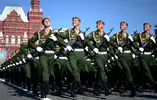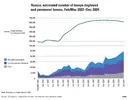10th February 2025
Combat losses and manpower challenges underscore the importance of ‘mass’ in Ukraine
Ukrainian forces managed to blunt Russian territorial advances and inflict significant casualties and material losses in 2024, even with ammunition shortages and a deficit in infantry. However, Ukraine will need continued Western support and better manpower-management to avoid further battlefield setbacks.
This blog post was first published on the Military Balance+ on 6 February 2025
While 2024 was a difficult year for Ukraine on the battlefield, its armed forces have managed to limit Russian territorial advances and inflict significant losses. These outcomes, achieved despite Ukraine’s acute shortage of ammunition in the first half of 2024 and manpower difficulties, show that Russia’s successes on the battlefield are certainly not decisive.
Equipped but not staffed: Ukraine’s challenge for 2025
Ukraine’s armed forces are not currently facing a critical situation with regards to equipment; however, they will likely need significantly more weapons, especially modern Western-made systems, to reliably stop Russian assaults. Launching offensives and liberating occupied territory would require considerably more materiel. If the West were to reduce or halt its support, the situation would seriously degrade in the medium term.
Three years after Russia launched its full-scale invasion of Ukraine, the first results of joint ventures, partner programmes and larger contracts between Ukraine and various defence companies and governments in the West are progressively bearing fruit. These will likely pick up steam throughout 2025. Furthermore, Ukraine’s own defence industry has been able to adapt, producing some key equipment at scale, such as the 2S22
Bohdana self-propelled artillery system at a reported production rate of 16 per month. This can be seen from the diverse range of units across the Ground Forces, National Guard and Marines equipped with the 2S22.
Nevertheless, the main challenge Ukraine currently faces is manpower, specifically with regards to management and allocation.
Several of the newly formed brigades, for example, the 152nd Jaeger and 155th Mechanised, went through a chaotic formation process, with entire battalions being detached and sent to replenish depleted frontline brigades. This resulted in longer than usual forming up periods and troops suffered from inadequate training. These newly formed brigades, such as the 150th Mechanised, were sent to parts of the frontline that were experiencing some of the harshest combat and suffered significant casualties.
Ukraine’s military has only ad hoc command formations above the brigade level, making inter-brigade communications and cooperation uneven and difficult, and in the worst cases causing gaps on the frontline. Infantry battalions’ attrition remains the highest, with reported staffing figures ranging from 20–30% of full strength. The number experienced personnel in these units is dwindling, all the while they face skilled drone pilots and artillery operators, which aggravates the problem.
These command and manpower management problems are regularly mentioned by Ukrainians as a dissuasive factor to volunteer for service. Ukraine’s most elite and prestigious units advertise and recruit directly and have fewer manpower-shortage issues. If Ukraine addresses these problems, it could noticeably improve its military capabilities. The country still has enough non-mobilised manpower to fully staff its depleted units, with its need estimated as between 50,000 and 100,000 additional personnel. The Ukrainian government’s latest nominations and proposed reforms are aimed at tackling these issues.
Staffed and decently equipped: Russia’s outlook for 2025
The IISS estimates that Russian equipment losses in 2024 amounted to around 1,400 main battle tanks (MBTs) and more than 3,700 infantry fighting vehicles (IFVs) and armoured personnel carriers (APCs). In total, Russia is estimated to have lost approximately 14,000 MBTs, IFVs and APCs since it launched its full-scale invasion of Ukraine.
Despite these staggering numbers, Russia has been able to reconstitute some of these losses by relying on stored Soviet legacy equipment. The IISS estimates that last year, Russia refurbished and built more than 1,500 MBTs and around 2,800 IFVs and APCs. Equipment remaining in storage is highly likely to be in a deteriorated condition, which may make it difficult for Russia to deliver enough equipment to offset previous attrition rates.

In late 2024, Military Balance+ data showed that Russia’s active equipment numbers* only just reached a level similar to pre-February 2022. The significant expansion of units has exacerbated the deficit of equipment required to reach full strength. This issue is also compounded by a lack of quality and a potential lack of spare parts. The main issue that Russia suffers from is a dearth of IFVs and APCs, even with greater rates of production. However, Russia has adapted its tactics, which try to mitigate these issues by relying on stopgap measures and further infantry-based assaults to push the frontline.
Like equipment losses, it is difficult to know the exact number of Russian casualties. However, as of early January 2025, the IISS estimates that a minimum of 172,000 Russian troops have been killed and 611,000 wounded, of which at least 376,000 are severely wounded (disabled), with up to an accumulated 235,000 wounded but recoverable. Russian recruitment, including the forced mobilisation in
occupied Donbas, the mobilisation in 2022, and
recruiting from the prison system, has generated approximately 976,000 personnel for the war effort. Up to 617,000 – including those recoverable wounded and those undergoing training – are therefore estimated by the IISS to be deployed in or near Ukraine as of late December 2024.
The bottom line
While Russian forces are likely to degrade in the coming months, they have been sufficiently reconstituted and adapted to sustain offensive operations for at least another year; this would, however, come at a very high cost of equipment and casualties. The situation is not as dire for Ukraine as it was in early 2024, but it will still rely on Western support and improving its manpower-management to avoid further setbacks on the battlefield.
*
Current numbers in The Military Balance 2025,
also accounts for equipment deployed, in reserve, used for training, in maintenance and undergoing repairs.







 drone läpäisee vaunun kyljen ja ammustäyttö selvästi syttyy räjähdysmäisenä ruutipalona, oliko tuo äijä vaunun vieressä ulkona, liekit lyö kuskin luukustakin, ei siellä sisällä kukaan ammusten lähtiessä tajuissaan pysy / pääse enää lojahduksen jälkeen pihalle
drone läpäisee vaunun kyljen ja ammustäyttö selvästi syttyy räjähdysmäisenä ruutipalona, oliko tuo äijä vaunun vieressä ulkona, liekit lyö kuskin luukustakin, ei siellä sisällä kukaan ammusten lähtiessä tajuissaan pysy / pääse enää lojahduksen jälkeen pihalle




